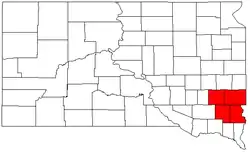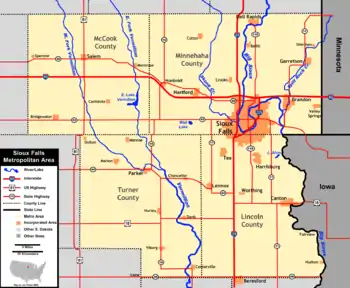Sioux Falls, South Dakota metropolitan area
The Sioux Falls Metropolitan Statistical Area, as defined by the United States Census Bureau, is an area consisting of four counties in South Dakota, anchored by the city of Sioux Falls. The metro area is referred to locally as the Sioux Empire. Despite the name, it is considered a part of the larger area known as Siouxland as it is within the Big Sioux River basin. As of the 2010 census, the MSA had a population of 228,261.[1]

Counties
Communities

| Historical population | |||
|---|---|---|---|
| Census | Pop. | %± | |
| 1900 | 23,926 | — | |
| 1910 | 29,631 | 23.8% | |
| 1920 | 42,490 | 43.4% | |
| 1930 | 50,872 | 19.7% | |
| 1940 | 57,697 | 13.4% | |
| 1950 | 70,910 | 22.9% | |
| 1960 | 118,373 | 66.9% | |
| 1970 | 139,076 | 17.5% | |
| 1980 | 139,076 | 0.0% | |
| 1990 | 153,500 | 10.4% | |
| 2000 | 187,093 | 21.9% | |
| 2010 | 228,261 | 22.0% | |
| 2018 (est.) | 265,653 | 16.4% | |
| U.S. Decennial Census[2] | |||
Places with more than 150,000 inhabitants
- Sioux Falls (Principal city)
Places with 1,000 to 10,000 inhabitants
Places with 500 to 1,000 inhabitants
Places with less than 500 inhabitants
Demographics
As of the census[3] of 2000, there were 187,093 people, 72,492 households, and 48,282 families residing within the MSA. The racial makeup of the MSA was 94.07% White, 1.25% African American, 1.56% Native American, 0.87% Asian, 0.04% Pacific Islander, 0.87% from other races, and 1.33% from two or more races. Hispanic or Latino of any race were 1.84% of the population.
The median income for a household in the MSA was $40,590, and the median income for a family was $48,191. Males had a median income of $30,994 versus $22,493 for females. The per capita income for the MSA was $19,184.
References
- "South Dakota". USA Today. Retrieved 2011-05-12.
- "U.S. Decennial Census". United States Census Bureau. Archived from the original on May 12, 2015. Retrieved April 12, 2020.
- "U.S. Census website". United States Census Bureau. Retrieved 2008-01-31.
